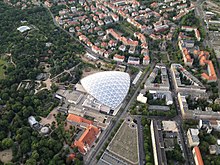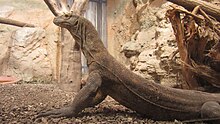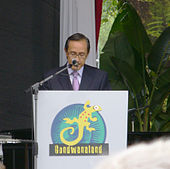Gondwanaland
Gondwanaland is the 16,500 square meter giant tropical hall in Leipzig Zoo . In the hall named after Gondwana , the primary continent in the southern hemisphere, around 100 animal species and 17,000 tropical plants are shown at temperatures of 24 to 26 ° C and a humidity of 65 to 100 percent .
Conception and construction
The construction of the largest tropical hall in Europe, which is intended to show the visitor the unity of the continents Asia, South America and Africa in geological development, was originally planned in the middle of the zoo, for example between the rhino and kiwara savannah at the apex of the Asian themed areas , Africa and South America. This plan was discarded and the former worsted spinning mill on Pfaffendorfer Strasse on the eastern edge of the zoo area was chosen as the building site.
In the competition announced in April 2006 for the hall, in which 17 applicants took part, the design by HPP Hentrich-Petschnigg & Partner from Düsseldorf emerged as the winner. HPP designed the zoo parking garage back in 2002. In the course of the second selection phase, however, a decision was made in favor of the second-placed design by Martin Henchion (* 1967) and Klaus Reuter (* 1964) from Henchion + Reuter Architects Dublin and Berlin. A working group consisting of OBERMEYER Albis-Bauplan GmbH Chemnitz (design), Eisenloffel Sattler + Partner Berlin (structural engineering), experts from the zoo and the architects Henchion + Reuter was commissioned to plan the construction. The steel construction was carried out by Eiffel Deutschland Stahltechnologie GmbH from Hanover.
The design comprised a construction field of 2.7 hectares, of which 1.65 hectares were taken up by the tropical hall with the floor plan of a Reuleaux triangle . The roof shape of a spherical triangle enabled a large building volume and a considerable height (approx. 36 meters ridge height in the middle of the roof), but also an adaptation to the neighboring buildings by reducing the eaves heights to 10.1 meters at the three corners. At the high point in the middle of the long sides, the primary structure protrudes 17.2 meters above street level. It is freely spanned over 154 meters and still has a construction height of only 1.4 meters. The clear height in the hall is up to 34.5 meters (in the middle of the hall).
After long preparations, an asbestos removal of the factory buildings as well as agreements on the protection of monuments and desensitization of the zoo animals, the industrial block of the factory was blown on February 24, 2007. For the demolition, the Thuringian Sprenggesellschaft dug 400 boreholes and placed a total of 150 kilograms of explosives in them. Most of the construction waste generated was recycled and later used again. The small amount of contaminated sites turned out to be a stroke of luck for the zoo. After most of the rubble had been removed, the leveling and deepening of the excavation began.
The symbolic groundbreaking ceremony took place on November 28, 2007, attended by zoo director Jörg Junhold and mayor Burkhard Jung , among others . The foundation stone was laid at the end of 2007. The civil engineering work finally began in May 2008. From May 2009 the roof rack was installed. Since July 2009, civil engineering work has been going on to set up the rear animal husbandry in Gondwanaland, which is also used as a quarantine area. The construction was completed in January 2010. On October 30, 2009, the topping-out ceremony of the hall with the completion of the primary structure was celebrated in the presence of 600 guests. Construction work on the secondary structure began in winter 2009/2010. The complete roof construction including foil cushions was completed in June 2010. Work on the interior of the hall began in July 2010, the first plants were planted in February 2011, and the first animals moved into the enclosures in May.
In 2007 the construction cost for the hall was estimated at around 49.5 million euros. Because of the drastic rise in steel prices, this amount had to be revised upwards by around 10.5 million euros in 2008 and by a further 6 million euros in 2010 due to the bankruptcy of a construction company that was heavily involved. The financing of the hall could still be secured. A total of around 66.8 million euros were invested, of which around 32 million came from the Free State of Saxony, 11.5 million from the city of Leipzig and over 23 million from the zoo itself. 1.6 million euros came from donations and animal sponsorships.
Structure and subject areas
The main entrance of the hall with a foyer is on Pfaffendorfer Straße right next to the zoo's business entrance. From the grounds of the zoo itself, visitors can reach the hall via an entrance building on the south-west corner of the historic predator terraces from 1929 (part of this facility had to be demolished for this purpose). Over a bridge over the Parthe , visitors move through a gorge, the east side of which forms a vertical garden , and dive deeper and deeper into the vegetation to finally reach the access tunnel. This not only has a feeding character - it also contains a path of evolution , where the visitor is presented with living beings in a nocturnal and a diurnal animal section, which are considered to be "living fossils".
These include:
- Protect fish , lungfish species of three continents (Africa, South America, Australia), Red Congo Tetra , Spritzsalmler , Red Eye Tetra , long-bearded calluses catfish , Australian Perlmutter Rainbow Fish , dwarf rainbow fish , spotted gars
- Smooth-backed snake-necked turtles , Komodo dragons
- Kowaris , spotted martens or quolls and dwarf plumploris . The northern opossum female Heidi , who became known through the media, was also based here. After the death of the last animal in April 2012, this species is no longer represented in the zoo's population.
The starting point for the tour in the tropical hall is a “ pile dwelling village ” in the jungle. From there, visitors have the opportunity to explore the hall on foot or by boat. The 390 meter long boat canal, designed as a primordial river, was named "Gamanil" when it was flooded on May 5, 2011, derived from the names of the largest rivers in Asia, South America and Africa, the Ganges , the Amazon and the Nile . There are 12 boats with 16 seats each moving on an endless chain; the circuit in the 1.20 to 1.50 meters deep water begins with the 4½-minute crossing of an underground tunnel. After this dark cave area, in which the emergence of the ancient continent Gondwana is staged using multimedia, the boats leave the cave through a grotto and dive into the tropical rainforest. The 11-minute boat tour continues through the three continent areas of the hall. From the surface of the water, visitors have a clear view of the flora and fauna of the rainforest.
There are many different ways: dirt paths, stony paths through rocks, sand paths or paths through dense vegetation. One component of the circular route is a “treetop path” over 90 meters long at a height of 12 meters, which stretches like a spider's web through the jungle between the giants of the jungle and a rock face. In every continent area it is also possible through deeper trenches and tunnels to observe animals at the level of the water surface, on the ground and through aquariums also underwater. There is also a ten-meter high waterfall in Gondwanaland.
Apart from the treetop path, which can only be reached via suspension bridges, the circular path and the boats were designed to be barrier-free and are also wheelchair accessible.
In addition to a souvenir shop, the hall also has a restaurant and an event area for celebrations and meetings.

The animal population of the individual continent areas of the hall:
Asia:
- Giant gouramis , Brass Barben , diamond Barben , Kaiser snakeheads , Rotband- snake heads , siamese catfish , Black Frans Lipper , Tiger barbs , Hengel wedge spot barbel
- Black-spotted winker frogs
- Komodo dragons (largest lizard species in the world), temple turtles , Borneo river turtles , rays, three-Kiel turtles , brown turtles , pig-nosed turtles , Sunda gavials
- Wrinkled hornbills
- Black-backed tapirs , fish cats , dwarf otters
Africa:
- Marian cichlids
- Clay reed frogs
- Radiated tortoises , blue Bambustaggeckos , Himmelblaue Zwergtaggeckos , yellow-headed dwarf gecko
- Owl's monkeys , Diana monkeys , pygmy hippos , crowned lemurs and kirk dikdiks
South America:
- Leaf cutter ants
- Black thorn catfish , arapaimas , black pacus , long-snouted pike , red-fin catfish
- Yellow-banded tree climbers , green iguana
- Arrau rail turtles
- Giant Otter , Common squirrel monkeys , ocelots , two-toed sloth , acouchi , silver monkey , white-bellied pygmy marmoset and white-faced saki
While the majority of the animal population is kept in differently designed and dimensioned enclosures (see above), some animal species have unlimited access to the air space, the water areas and the jungle floor. So far, these include:
- Praying mantises
- White's tree frogs , dyers frogs , Striped phyllobates , red tomato frogs , Siamese brown frogs , greenhouse frogs , Horn Rag rhacophoridae , Small staurois , green and black poison dart frog , red-eyed tree frogs , two-colored poison dart frogs , Mitchells reed frogs and rice frogs
- Bahama anole , blue-headed anole , white-lipped anole , green iguanas , green water dragons , frontal-lobed basilisks , Madagascar day geckos , aldabra day geckos , peacock-eye day geckos , gold dust day geckos , Pasteur's day geckos and dwarf striped geckos
- Strauss quail , Yellow Whistling Ducks , Small Amazon ducks , Radjahgänse , African Pygmy Duck , Little Cuba finches , Jacarinifinken , Sunbittern , two-color fruit pigeons , Madagascar Weber , Rotohrbülbüls , Schamadrosseln , Hartlaubturakos , collar pigeons , pagodas Stare , mask lapwings , Mähnenibisse , Schuppenkopfrötel , Venezuela Blaukehlguane , collar Lieste , Mohr moorhens and Sulfur mask cantyrants
- Vietnam island bats
In order to ensure that the tropical hall offers not only a varied population of small and large animals but also a great variety in botanical terms, a total of 131 large trees (6 to 12 meters high) were imported from specialist nurseries in Florida and Southeast Asia and brought to Rotterdam by sea in special containers . In specialist nurseries, the plants were used to the lower solar radiation in Central Europe and were transplanted into the hall in late autumn 2010. 415 trees or plants are medium-sized plants (3 to 5 meters), but most of the tropical vegetation consists of small plants, a total of 16,000 specimens of 500 species can be found in the hall.
Air conditioning

The tropical plants and animals require constant temperatures and humidity all year round. For this purpose, a system of heating and cooling systems was installed, which is based partly on district heating and partly on energy recovery. Part of the energy is obtained from solar panels on the roof. The water consumption is partially covered by treated rainwater. The hall is roofed with a spherical , form-active bar dome . Two levels are arranged one above the other. On the outside there is a steel-saving primary structure in a triangular grid, from which a more filigree secondary structure based on a rectangular grid is suspended with tubular profiles. The secondary structure also forms the drainage channels, which are supplemented by a circumferential main drainage channel that guides the rainwater into tanks for further use. The distance between the primary and secondary structure is around 1.8 to 3.5 meters.
The approximately 17,900 m² roof skin is formed by 411 pneumatically pre-tensioned ETFE film cushions. These each consist of three layers of film in the spaces between which an overpressure of 250 Pa is built up using compressed air , which forms the film into a two-chamber cushion and thus pretensions and stabilizes it. For snow loads, the pressure can be increased to 800 Pa. The pillows should guarantee optimal thermal insulation and at the same time maintain full light entry including sufficient UV radiation into the room below. They can also be heated to keep the roof free of snow.
To maintain a constant temperature, the hall is cooled by air exchange in summer and heated in winter if required. Two main ventilation systems are designed to prevent the hall from overheating. At temperatures above 28 ° C, the skylights open, warm air escapes to the outside and cooler outside air flows in via controllable ventilation louvers in the facade. If the natural air flow becomes too low, fans installed on the side switch on; these are designed for an air volume of 600,000 cubic meters per hour. In addition, the ventilation systems have heat recovery . For this purpose, the hot air under the hall ceiling is extracted via a concrete column disguised as a giant tree and fed into a 100 cubic meter geothermal energy storage unit via a heat pump .
In order to achieve the high humidity, water is sprayed on the ventilation inlets. The large waterfall provides basic humidification. Rainwater is mainly used for humidification, which is collected in four cisterns with 588 cubic meters and two day tanks with 30 cubic meters each.
opening
The Gondwanaland tropical hall was opened on June 30, 2011 by Saxony's Prime Minister Stanislaw Tillich and Leipzig's Mayor Burkhard Jung with the symbolic handover of a machete to zoo director Jörg Junhold, with which he then cut the ribbon. Afterwards, the zoo celebrated with 1,500 invited guests - among them Saxony's Minister of Social Affairs Christine Clauss , the group Die Prinzen and the Minister for Tourism, Culture and Environment of the Malaysian state of Sabah YB Datuk Masidi Manjun - the completion of the largest and most cost-intensive project since the end of the 1990s -Years realized the concept zoo of the future .
Since July 1, 2011, Gondwanaland has been accessible to all zoo visitors. Since then, the Swiss zoologist and senior curator Fabian Schmidt, the son of the former director of the Frankfurt am Main zoo , Christian R. Schmidt , has been responsible for the tropical hall .
literature
- Gondwanaland tropical adventure world. (Leipziger Blätter, special issue), Passage-Verlag, Leipzig 2011, ISBN 978-3-938543-95-5
- Gondwanaland. Leipzig's unique tropical world. 40-page supplement to the Leipziger Volkszeitung dated June 30, 2011
- Diethard Kiehn, Jan Mehnert: Urkontinent as a world of experience. Gondwanaland giant tropical hall at Leipzig Zoo. (PDF; 4.2 MB) In: Outlines - Zeitschrift für Baukultur , 11 (2011) H. 1, pp. 39–44, ISSN 1437-2533
Web links
Individual evidence
- ↑ a b c d e Facts and figures about the giant tropical hall. Publishing supplement of the Leipziger Volkszeitung , June 30, 2011, p. 34
- ↑ Mustafa Haikal ; Jörg Junhold: On the trail of the lion. 125 years of Leipzig Zoo. Pro Leipzig, Leipzig 2003, ISBN 3-936508-95-X , p. 252 f.
- ↑ HPP Architects : Parkhaus am Zoo. (PDF)
- ↑ a b A tropical area in the middle of the city. Leipzig Zoo starts its largest project in 2005. Publishing supplement of the Leipziger Volkszeitung , June 30, 2011, p. 9
- ^ Outlines - Zeitschrift für Baukultur , issue 1/2011, p. 40
- ↑ Riesentropenhalle, Zoo Leipzig: A breathing structure References, Eiffage SEH (formerly Eiffel Germany)
- ↑ Maiden voyage at the Gamanil Zoo Leipzig, May 5, 2011
- ↑ Kerstin Decker: Jungle boats stand still. Technical defect in Gondwanaland. In: Leipziger Volkszeitung , August 17, 2011, p. 19
- ↑ Dragon meets Grande Dame. Komodo dragon and sunda gavial meet in Leipzig. Publishing supplement of the Leipziger Volkszeitung , June 30, 2011, p. 18
- ↑ Great climate under the foil roof. Sophisticated system for water, heat and air relies on renewable energies. Publishing supplement of the Leipziger Volkszeitung , June 30, 2011, p. 16
- ↑ Chief of the jungle world. On: tagblattzuerich.ch from 7 July 2015.
- ↑ "Higher, wilder, more natural": Senior curator Schmidt over 5 years in Gondwanaland. On: zoo-leipzig.de from June 24, 2016.
Coordinates: 51 ° 21 ′ 1.6 ″ N , 12 ° 22 ′ 17 ″ E






